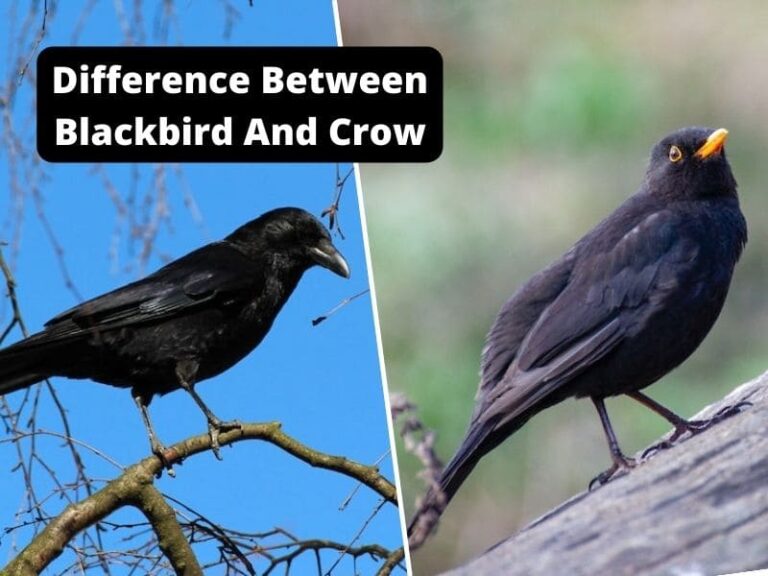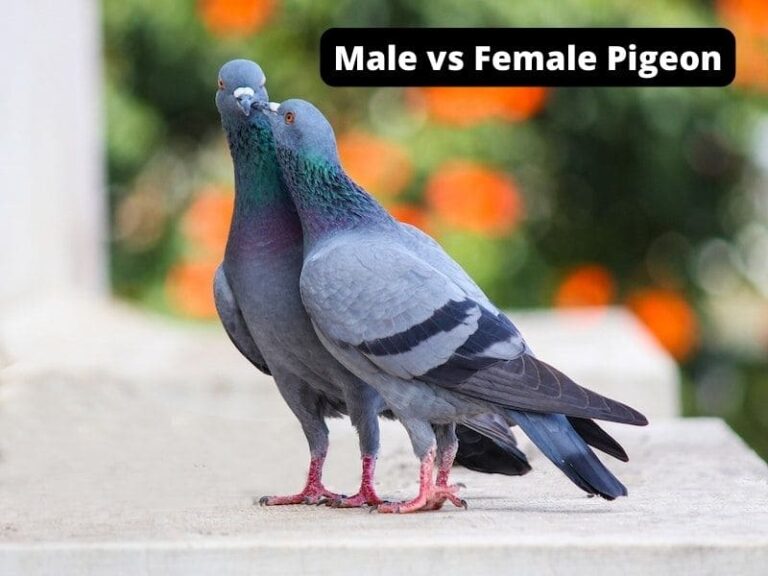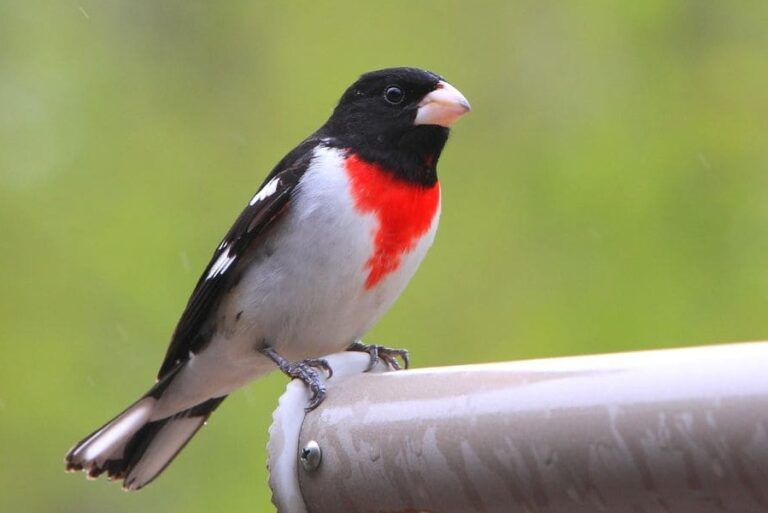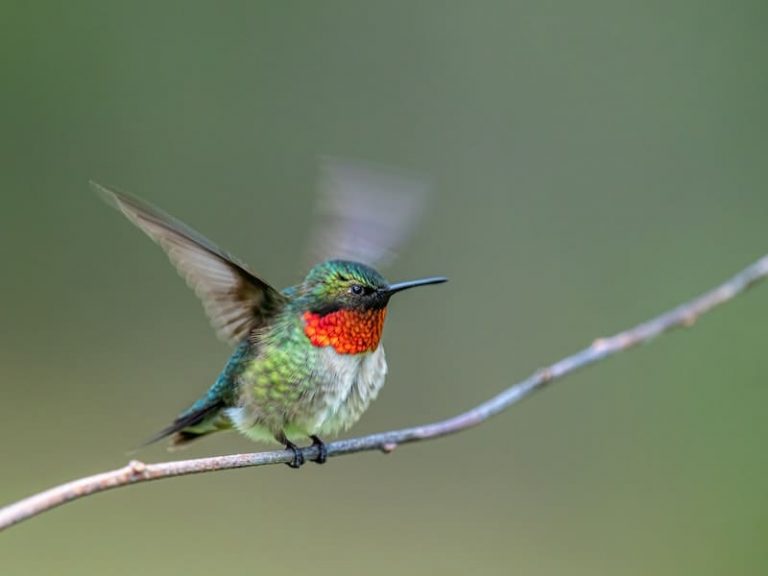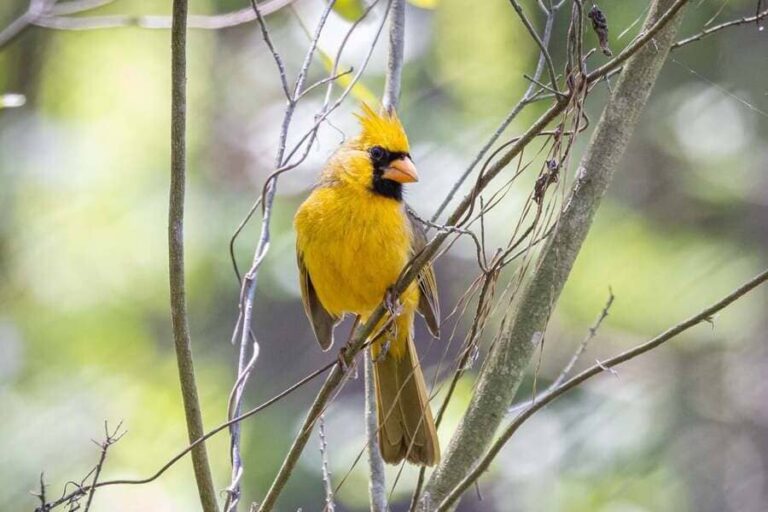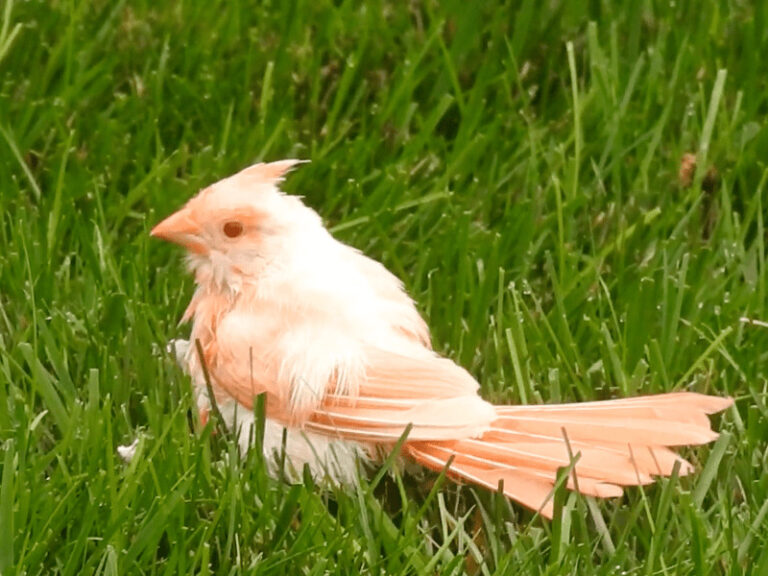8 Types of Blue Birds in Washington State
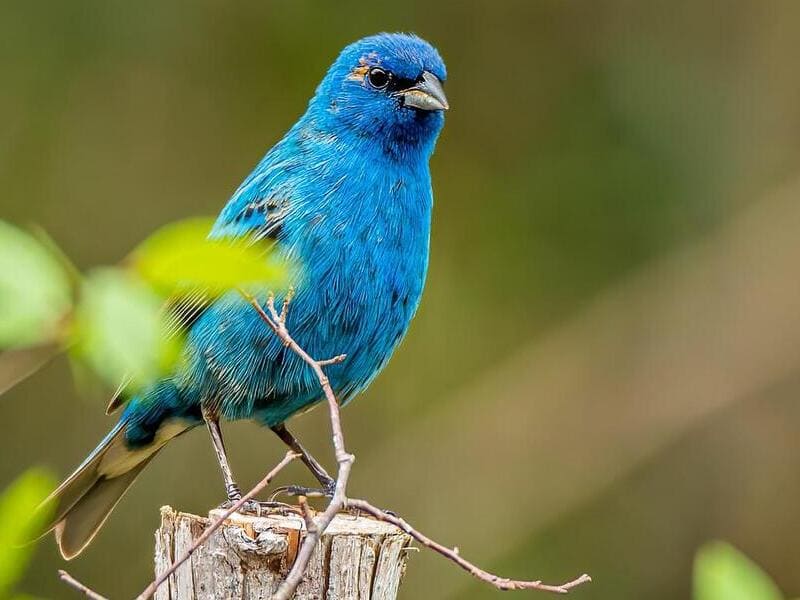
Several bird species are native to Washington State or visit it during different seasons. It is a great state for birds to live in, and it offers food, shelter, a breeding ground, and a rich habitat to foster their babies.
Many types of blue birds are found in Washington State. They may have visited your garden to have a bite on bird feeders, perched on the balcony, or flown across to give a glimpse of their blue plumage.
In every way, they showed their beauty to leave you amazed. This article will introduce you to 8 types of blue birds in Washington State and their identification features. So, stay put and read it through to identify the name of the blue bird you watch in your backyard.
Blue colored birds in Washington State
The blue-colored birds are not at all the same as the color suggests. They have different sizes, diets, prominent features, and plumage to exhibit their unique identity. You can spot these birds in Washington State all year long.
Some are here to breed, while others are migrating across the state. This article will help you identify all these birds next time you cross paths. Let’s start with their different features to distinguish them from each other.
Indigo Bunting
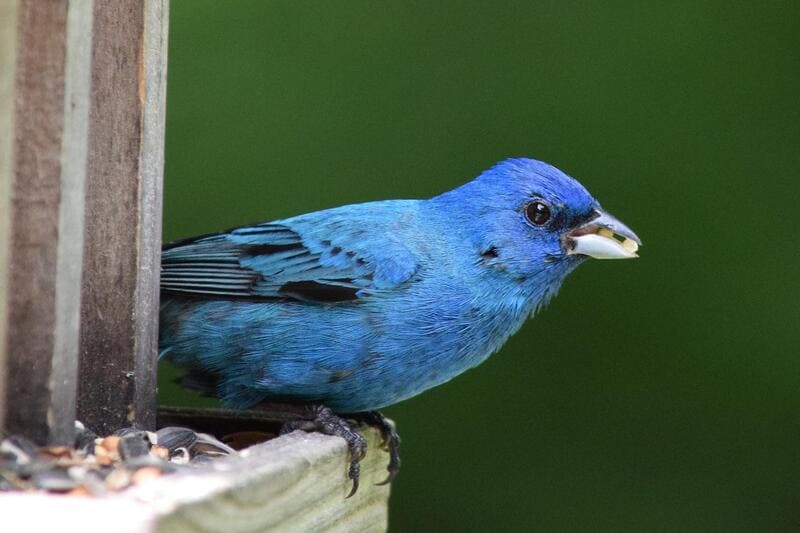
- Length: 4.5 to 5.9 inches
- Wingspan: 7.1 to 9.1 inches
- Weight: 0.40 to 0.75 oz
- Diet: Insectivores and Granivores
- Egg Color: Unmarked White to bluish-white
- Clutch Size: 3 to 4 eggs
- Appearance: Indigo-blue color
- Most Prominent Feature: Short tail and a conical bill.
- Nesting: Within one meter of the ground. In fields, edges of woods, railroad, roadside.
Indigo bunting is a local symbol of Florida due to its distinctive color. The male has bright blue plumage with a more dense color at the head, while the female presents brownish plumage with a white throat. They are one of the smallest local birds, only measuring a few inches in length.
The indigo bunting could be the most abundant songbird seen along every roadside when talking about blue birds in Washington State. Their song can be explained as a rapid, excited warble, and each note sang twice.
They nest one to three feet above ground in dense shrubs or low trees. The female lays three to four eggs and the incubation period lasts 12 to 13 days. The baby birds are fed only by mothers with primary insects. The indigo bunting eats insects in summer and seeds in winter. They are migratory birds that move from Canada to Florida in winter and do the opposite in summer.
Painted Bunting
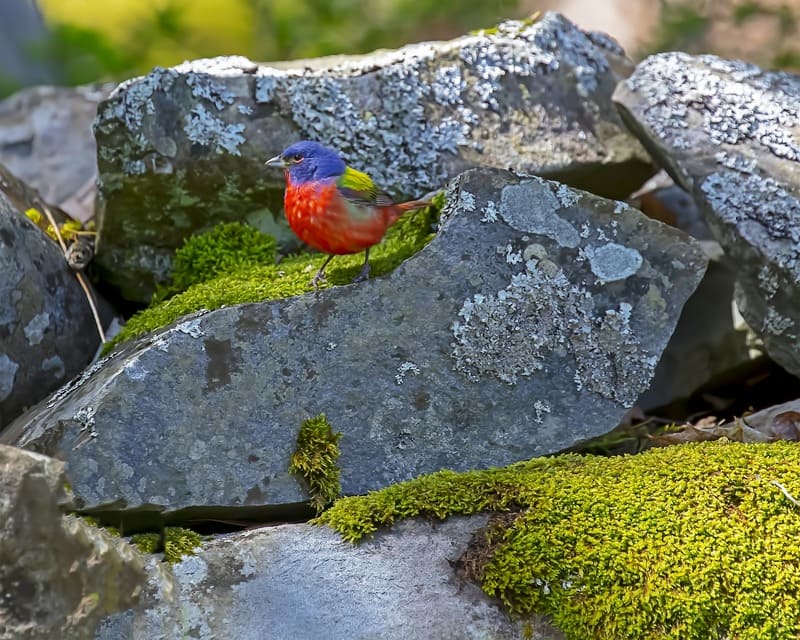
- Length: 4.7 to 5.5 inches
- Wingspan: 8.3 to 9.1 inches
- Weight: 0.46 to 0.67 oz
- Diet: Insectivores and Granivores
- Egg Color: Pale or Grayish bluish-white with brown and gray speckles
- Clutch Size: 3 to 4 eggs
- Appearance: Blue heads, red underparts, and green backs
- Most Prominent Feature: Bright red underparts and yellow upper back. Red eyering.
- Nesting: Within two meters of the ground. Woodland edges, roadside, shrubs, or small trees.
Another species of blue-colored birds in Washington State, Painted buntings, are medium-sized songbirds. Moreover, they are common throughout the US and fly towards the South in winter through the Mississippi flyway. They migrate back west to spend their summer.
They are called painted due to their very colorful plumage. The male has a blue head, bright red throat and underparts, with a yellow patch on the upper back and red lower back. The females are uniformly bright yellow-green with a pale yellow eyering. The call of a painted bunting is loud, clear and variable, with several high-pitched musical phrases.
Their diet includes a combination of seeds, berries, suet, and insects. The female lays three to four eggs and incubates them for 11 to 12 days. Once hatched, the young birds leave the nest after 12 to 14 days. Mothers feed them exclusively, but the male can also take the responsibility if females start nesting again.
Pinyon Jay
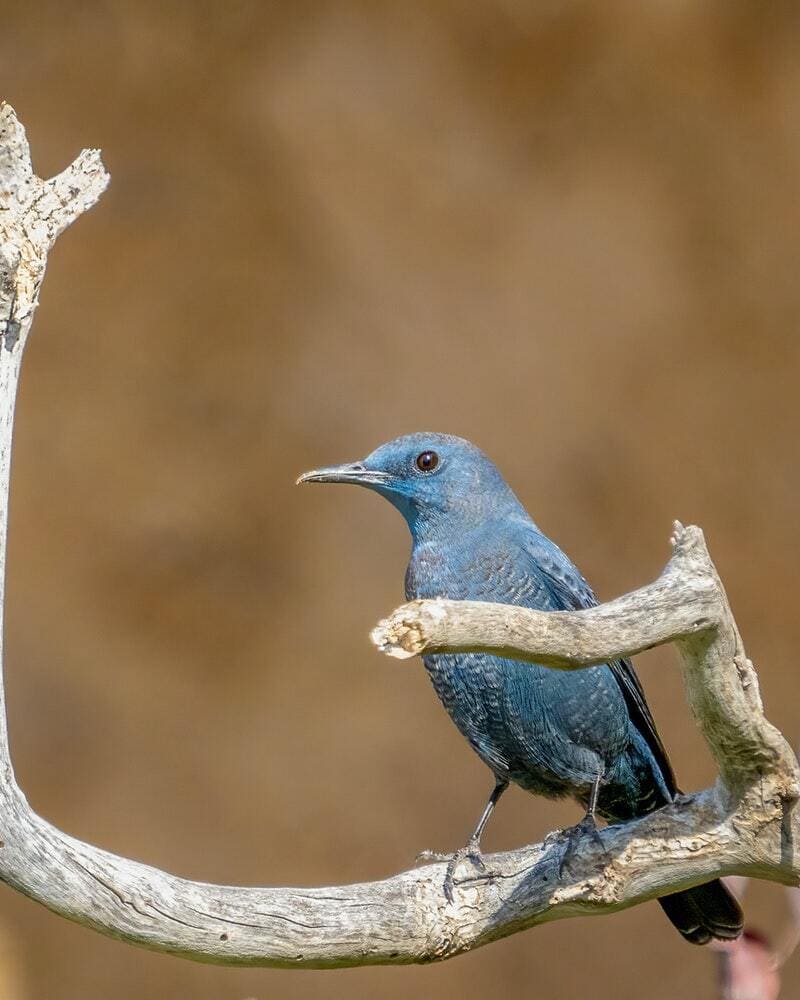
- Length: 10.2 to 11.4 inches
- Wingspan: 17.0 to 18.1 inches
- Weight: 3.2 to 4.2 oz
- Diet: Omnivorous, mostly Pinyon-pine seeds.
- Egg Color: Pale Blue
- Clutch Size: 4 to 5 eggs
- Appearance: All body dull blue except chin, throat, and breast region streaked white.
- Most Prominent Feature: Pointed bill and shorter tail compared to other jays.
- Nesting: Nest in colonies but not more than one nest per tree.
Although native to Mexico, pinyon jays are very common in Washington State. The male has dull blue plumage throughout except for a whitish chin. The female shows bluish-gray colors overall. They have sharply pointed longer bills and shorter tails compared to other jays.
Their call is identified as a high-pitched ‘caa’ that resembles a laughing ‘haa-a-a-a’ at the end. The pinyon jays dwell in almost every environment, from dry forests to swamps and dunes to hillsides. They eat grains, wild berries, small mammals, insects, lizards, snakes, and nestling birds.
They nest in colonies with not more than one nest per tree. The female lays a clutch of four to five eggs that hatch after 16 to 17 days. Both parents perform the duty of feeding their nestlings that leave the nest after three weeks of hatching.
Steller’s Jay
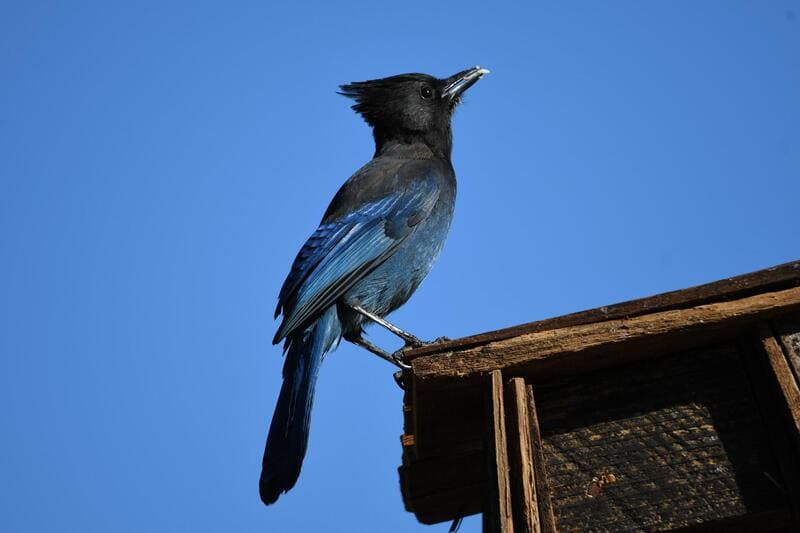
- Length: 12 to 13 inches
- Wingspan: 15.5 to 17 inches
- Weight: 3.5 to 4.9 oz
- Diet: Omnivorous, primarily nuts, but can also eat other birds’ eggs.
- Egg Color: Light blue with light brown spots
- Clutch Size: 2 to 6 eggs
- Appearance: Bright blue and charcoal black
- Most Prominent Feature: Dark black crest on its head
- Nesting: Horizontal branch of a conifer tree near the top of the tree.
Steller’s Jay is a common backyard bird in Washington State. The males are half charcoal black and half blue with a hefty black crest on the head, but some birds can have blue streaks on their crests. The female has similar plumage but in lighter colors.
Their call is a shack-shack-shack or chook-chook-chook sound. They can mimic the scream of a hawk. The female lays two to six eggs hatch after 16 to 18 days. Male and female are equally responsible for bringing food to baby birds.
Western Scrub-Jay
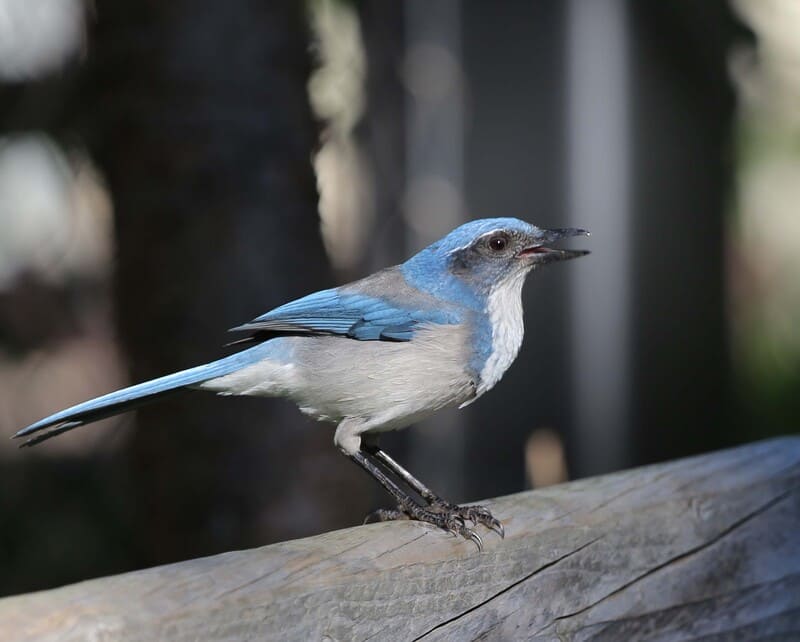
- Length: 11.0 to 11.8 inches
- Wingspan: 13.5 to 15.3 inches
- Weight: 2.5 to 3.5 oz
- Diet: Omnivorous, fruits, nuts, berries, and insects
- Egg Color: Pale green or pale gray with brown spots
- Clutch Size: 3 to 5 eggs
- Appearance: Bright blue with a white belly and gray patch on the back
- Most Prominent Feature: Gray patch on the back
- Nesting: Basket-sized nest, low and concealed behind foliage
The western scrub-jay is another blue-colored bird found in Washington State. It is a brush jay species native to western North America.
They have small bills and long tails. The males have blue heads, tails, and wings with a whitish-gray underside, white throat, and brown upper back.
The call of a western scrub-jay is a loud throaty ‘jayy or jree.’ It delivers a long series of ‘check-check-check’ notes while flying. The female lays three to five eggs during the breeding season that incubate for 17 to 18 days. Both parents feed the nestlings.
Blue Jay
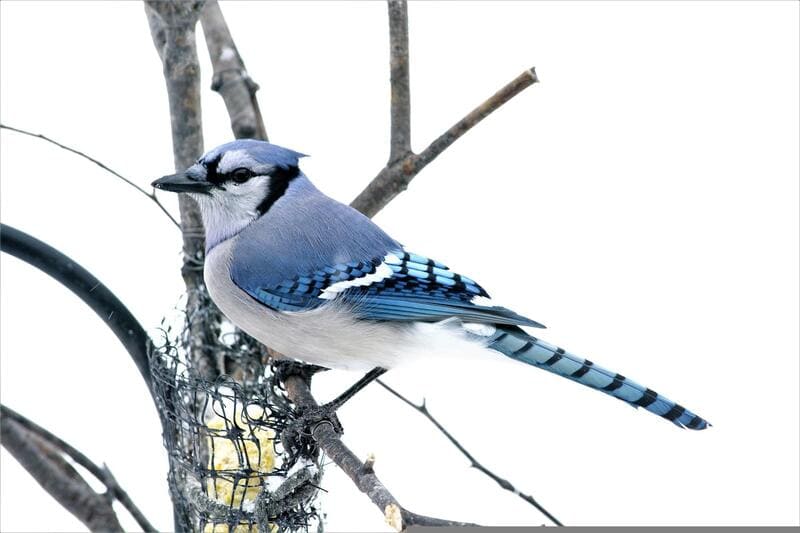
- Length: 9.0 to 12.0 inches
- Wingspan: 13.0 to 17.0 inches
- Weight: 2.5 to 3.5 oz
- Diet: Omnivorous, nuts, seeds, insects, small rodents, frogs, and baby birds
- Egg Color: Bluish with brownish spots.
- Clutch Size: 2 to 7 eggs
- Appearance: Bright blue and white plumage with a gray-blue crest on its head.
- Most Prominent Feature: Gray-blue crest on the head and a black necklace.
- Nesting: 10 to 25 feet above ground in the thick branches of coniferous trees.
The blue jay bird is native to north-eastern America and is commonly found in Washington State. They have some of the most beautiful plumage with blue above and white below. Their most prominent features include a blue crest and a black necklace.
It shows a wide variety of calls and songs. The most common call is a raucous ‘jay-jay.’ The clutch size is two to seven every season, and the eggs need 16 to 18 days to hatch. Both parents are responsible for feeding their nestlings that fly off after 17 to 21 days.
Recommended article: Blue Jay Feather Spiritual Meanings
Black-throated Blue Warbler
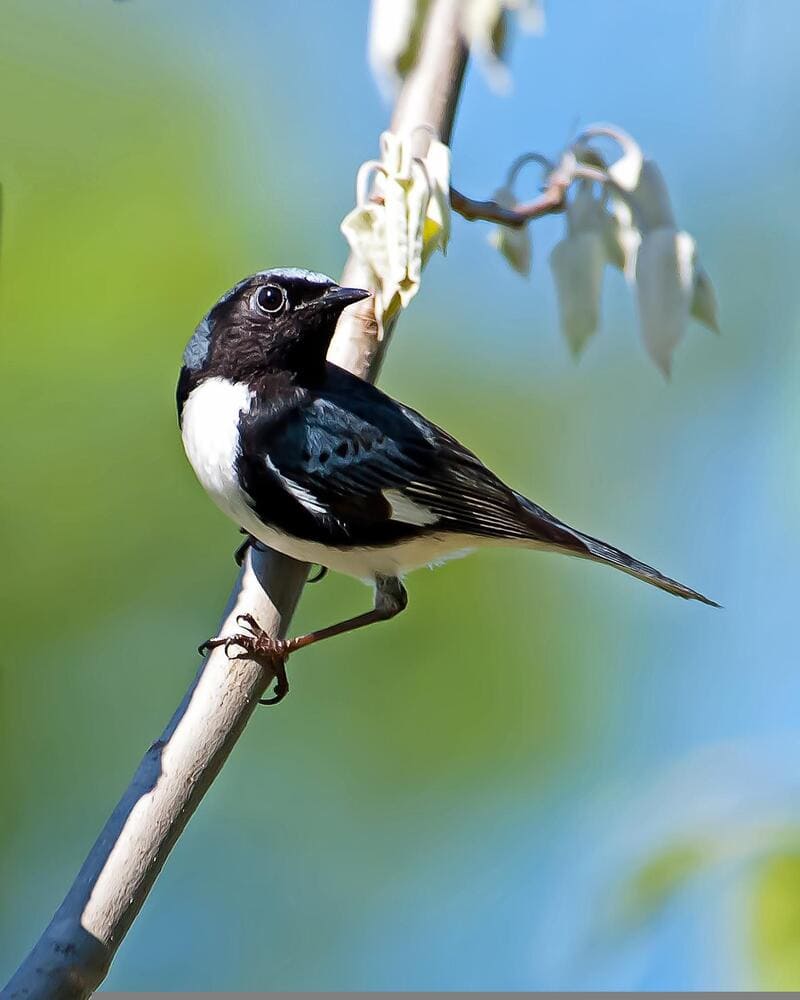
- Length: 4.3 to 5.1 inches
- Wingspan: 7.5 to 7.9 inches
- Weight: 0.3 to 0.4 oz
- Diet: Omnivorous, insects, small fruits, and berries.
- Egg Color: Creamy White with dark speckles.
- Clutch Size: 2 to 5 eggs
- Appearance: Dark blue and white plumage complemented with black
- Most Prominent Feature: Black face, throat, and sides.
- Nesting: Dense shrubs and saplings
When talking about blue birds in Washington State, it is impossible to miss the black-throated blue warbler. It is a small nocturnal bird with three to four years of lifespan.
The male has a blue back and head with a dark black face and throat. The underparts are white. The female has a plain grayish olive plumage with slight tints of blue on the tail and wings.
The call of a black-throated blue warbler is a husky rising ‘zwee-zwee-zwee.’ The clutch consists of two to five eggs that hatch in 12 to 13 days. The baby nestlings fly off within 8 to 10 days. Both parents feed their babies.
Western Bluebird
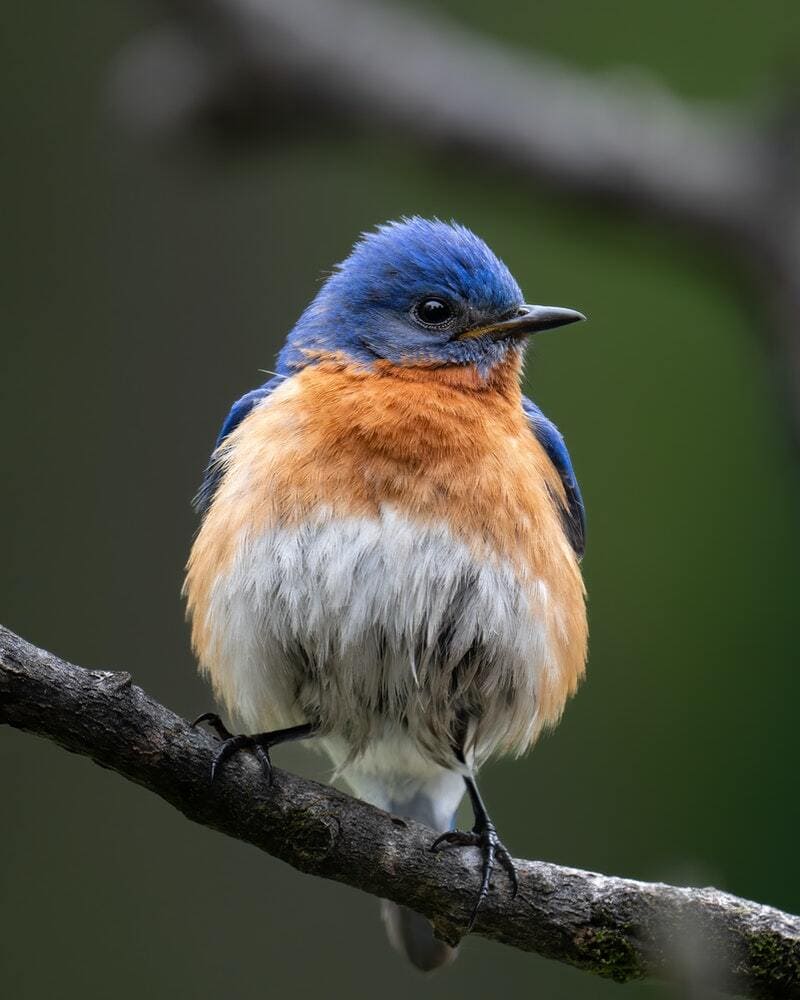
- Length: 5.9 to 7.1 inches
- Wingspan: 11.4 to 13.4 inches
- Weight: 0.8 to 1.1 oz
- Diet: Omnivorous, insects, berries, and small fruits.
- Egg Color: Unmarked pale blue
- Clutch Size: 2 to 8 eggs
- Appearance: Blue, rust-orange, and white.
- Most Prominent Feature: Buffed body with rust-orange breast.
- Nesting: Natural cavities in oak or pine and old woodpecker holes.
The western bluebird is another commonly found species in Washington State. It dwells in valley farms, orchards, and mountain pine forests.
Males have shiny blue heads, throats, and wings with rust-orange spread across the breast, sides, and upper back. The females have a dull plumage with pale orange breasts and shades of blue on their wings and tail.
It makes small sounds like ‘phew and chuck.’ Their call is a short, subdued ‘cheer, cheer-lee, churr.’ The female lays a batch of two to eight eggs that hatch between 12 to 17 days. The first flight of a baby bird took place after two to three weeks. Both parents feed their babies.
Recommended article: What Does It Mean Spiritually When You See A Bluebird?
How do I identify a bluebird?
The bluebirds are not very difficult to identify. The males have slender bodies in contrast to the buffy body of a female. Males have thin bills and a short tail, and so do female birds.
The plumage is rust-orange on the breast, sides, and back with blue on the head, throat, wings, and tail. The female shows duller colors with pale orange breasts.
Where are the bluebirds in Washington State?
When discussing finding bluebirds, you should look no further than Bickleton, Washington. It is considered the bluebird capital of the world, with the largest population of the bluebirds spending most of their year in the vicinity.
You can find the majority of bluebirds and a few western bluebirds in or around the forests. In Fort Lewis, a nest box program has increased the population of bluebirds in the area. No availability of nesting cavities is the most significant factor for the decline in the bluebird population.
How to find bluebirds in Washington?
The most important thing for a bluebird to live somewhere is the potential nesting place. They nest in natural cavities or old woodpecker holes. So, to find a bluebird, you have to look for three things; plenty of natural or artificial cavities, an abundance of water and food. Wherever you find these three things, chances are you will witness a bluebird. You can also attract bluebirds by placing a lot of nesting cavities in your garden, along with food and water.
Final Words
The chances of finding a blue-colored bird in Washington State are not very difficult due to the abundance of blue birds. Several magnificent species of blue color birds are located in the area.
So, this article about 8 types of blue birds in Washington State will help you identify the blue bird you are looking at on your next birdwatchers tour. The article has compiled all information about blue birds, from their song to plumage, their diet to nesting, and their eggs to breeding. Happy bird-watching for Washingtoners!
Interesting articles:

